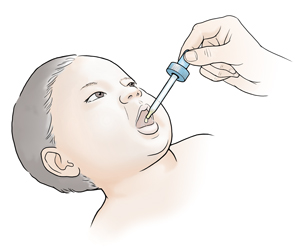Treating Sickle Cell Anemia in Children
Treating Sickle Cell Anemia in Children

Your child has sickle cell anemia. This is a condition passed down through genes. It affects the red blood cells (RBCs), the cells that carry oxygen. Your child will see a pediatric hematologist for treatment. This healthcare provider specializes in blood disorders (hematology). The goal is to help your child manage symptoms and prevent problems. This sheet tells you about treatments your child may get. Ask your healthcare provider if you have any questions because sickle cell disease can cause serious issues. Contact with your healthcare provider for any concerns.
Early treatments
Most newborns are tested for blood disorders like sickle cell anemia. If diagnosed, treatment starts right away. Early treatment includes the following:
-
Regular healthcare provider visits. These are needed so the healthcare provider can watch your child’s symptoms and overall health. A physical exam and routine blood tests are done to check for complications. These include anemia or problems with the liver, kidneys, heart, or lungs.
-
Antibiotics. These help prevent dangerous infections. Give them to your child exactly as directed by the healthcare provider.
-
Folate. This vitamin may be given to help your child build new RBCs and prevent worse anemia.
Other treatments
As your child gets older, treatments may change. Following are treatments that may be added to your child’s treatment plan. Each treatment has specific risks and benefits that the healthcare provider will discuss with you. In severe cases, your child may need to be in the hospital.
-
Medicines:
-
Hydroxyurea helps make the cells less likely to sickle. This helps prevent complications, such as pain episodes or acute chest syndrome.
-
Pain relievers help manage pain. Your child may get over-the-counter pain meds, such as acetaminophen or ibuprofen. Prescription strength medicines may also be used. For severe pain, prescription pain meds called narcotics may be given.
-
Antibiotics, such as penicillin, help fight infections and illnesses.
-
Iron chelators, such as deferasirox, to decrease iron overload that develops as a result of frequent transfusions.
-
-
Folate Your child’s healthcare provider may prescribe folate to help make more RBCs.
-
Blood transfusions can:
-
Increase the number of RBCs if anemia is severe
-
Help reverse a complication called acute chest syndrome when the lungs are affected by the sickle cells
-
Reduce the risk of stroke
-
-
IV fluids. Replacing fluids is part of the treatment of complications.
-
Surgery. In rare cases, surgery to remove the spleen or gallbladder may be needed.
-
Stem cell transplant. Transplants can provide cures. Studies of this treatment are ongoing.
How to prevent complications
-
Learn and watch for signs and symptoms of illness, infection, or more serious health problems.
-
Make sure your child receives all recommended vaccinations. This includes pneumococcal, meningococcal, and flu vaccines.
-
Give medicine as prescribed by the healthcare provider.
-
Make sure all recommended screening exams are done. These include tests for hepatitis C, retinopathy, and stroke risk.
-
Have your child avoid very hot or very cold temperatures. These can affect how well blood flows through the body.
When to call the healthcare provider
Call the healthcare provider if your child has any of the following:
-
Fever (see Fever and children, below)
-
Pain that doesn’t go away with pain medicine
-
Headache
-
Trouble breathing
-
Swelling of the hands or feet
-
Weakness in one side of body
-
Confusion
-
Erection that won’t go away
-
Pain in chest, stomach, legs
Fever and children
Always use a digital thermometer to check your child’s temperature. Never use a mercury thermometer.
For infants and toddlers, be sure to use a rectal thermometer correctly. A rectal thermometer may accidentally poke a hole in (perforate) the rectum. It may also pass on germs from the stool. Always follow the product maker’s directions for proper use. If you don’t feel comfortable taking a rectal temperature, use another method. When you talk to your child’s healthcare provider, tell him or her which method you used to take your child’s temperature.
Here are guidelines for fever temperature. Ear temperatures aren’t accurate before 6 months of age. Don’t take an oral temperature until your child is at least 4 years old.
Infant under 3 months old:
-
Ask your child’s healthcare provider how you should take the temperature.
-
Rectal or forehead (temporal artery) temperature of 100.4°F (38°C) or higher, or as directed by the provider
-
Armpit temperature of 99°F (37.2°C) or higher, or as directed by the provider
Child age 3 to 36 months:
-
Rectal, forehead (temporal artery), or ear temperature of 102°F (38.9°C) or higher, or as directed by the provider
-
Armpit temperature of 101°F (38.3°C) or higher, or as directed by the provider
Child of any age:
-
Repeated temperature of 104°F (40°C) or higher, or as directed by the provider
-
Fever that lasts more than 24 hours in a child under 2 years old. Or a fever that lasts for 3 days in a child 2 years or older.
Updated:
March 15, 2019
Sources:
Overview of the Management and Prognosis of Sickle Cell Disease. UpToDate
Reviewed By:
Bass, Pat F. III, MD, MPH,Image reviewed by StayWell medical illustration team.